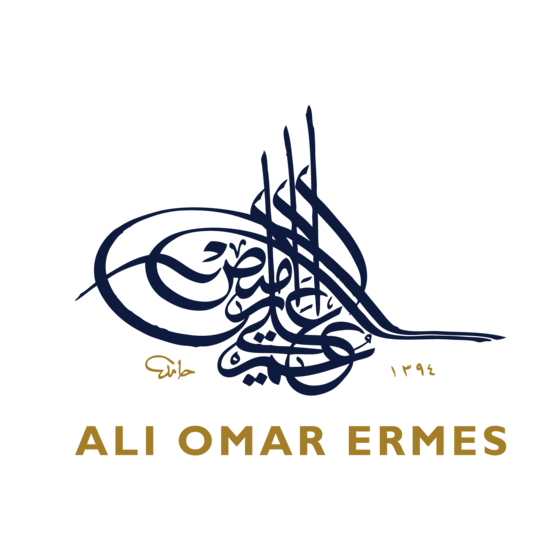Ali Omar Ermes’ Recent Works to Be Exhibited at Meem Gallery - 10 DECEMBER 2010 - 27 JANUARY 2011
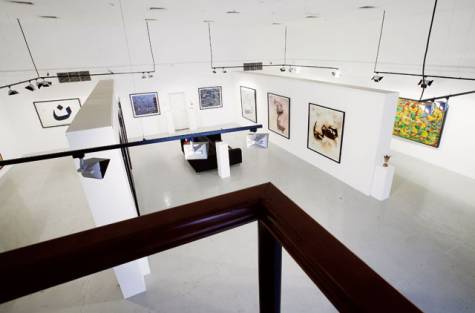
Meem Gallery is pleased to announce the opening of an exhibition of the recent work of Ali Omar Ermes this December. Ali Omar, who is internationally renowned for his beautiful paintings based on Arabic literature and letterforms, exhibited his work at Meem in 2007 and we are delighted to present his second solo show at the gallery this winter. The artist will be in attendance during the opening.
RECENT WORKS
The works being exhibited at Meem Gallery date from 1993 – 2010 and display the ongoing inspiration Ali Omar Ermes derives from the aesthetic form and meaning of the Arabic letter. Like many of the paintings in the artist’s oeuvre, this collection encourages viewers to engage with the powerful presence and etymology of the letter, using excerpts from poetry to reinforce the cultural significance of language. Poetic and literary references – in this collection he cites poets such as Ibrahim Al Bassary, Abi Tammam, Trafah Daiwan, Majani Al Adab, Al Qutami, Muhamed Ben Hani and Al Mutannabi - also highlight Ali Omar’s interest in larger social and cultural issues and reflect the artist’s interest in faith and spirituality.
Paintings such as Ghayatul Ghayn (2010) focus on the single Arabic letter, accompanied by poetic excerpts in smaller text. In this work, the importance of valuing the importance of endeavour and the pursuit of hard work is highlighted through the poetry of Ahmed Shawqi. It cites: ‘It is not by wishful thinking that you accomplish your dreams, as life is a struggle to win favour and defeat negativities’ (Daiwan and Moajam Al Abyaat Al Shahira).
Another work that will feature in the exhibition is Peace Means Justice (2010) which includes script from twenty-three different languages including Arabic, Latin, Sanskrit, Hebrew, Chinese, Javanese, English, French, Hausa, Swahili, Bengali, Urdu, Persian, Russian, Spanish, Portuguese, Italian, Swedish, Turkish, Kwanyama, German, Greek and Japanese. The text, translated from Arabic, states: ‘Implement justice in the world and you gain peace on earth.’
The Seven Odes of Arabic poetry, Al Muallaqat Al Sabaa (Prize Poems), is the inspiration for two works that will be displayed at Meem, titled The Fifth Ode and The Seventh Ode (1993). These paintings are part of a seven part series that celebrate the Prize Poems, verses which are particularly relevant in Arabic literature.
BIOGRAPHY
Ali Omar (b. Zliten, 1945) has held over sixty exhibitions worldwide, with work displayed or housed in the collections of institutions such as the British Museum and Tate Britain, London; Ashmolean Museum, Oxford; State Hermitage Museum, St. Petersburg; State Museum of Oriental Art, Moscow; Wereld Museum, Rotterdam; National Gallery of Jordan, Amman; State National Gallery, Malaysia; Smithsonian Institute, Washington D.C.; and LACMA, Los Angeles, among others in international public and private collections.
Ali Omar is also a deeply reflective writer whose articles have appeared in numerous publications in both English and Arabic. More recently, he has drafted a number of conference papers and delivered speeches in the UK, Europe and the Middle East on subjects such as identity, human rights, education, art and the media. The issues Ali Omar discusses in his written works are also the driving force behind many of his paintings, as he believes that the role of artists and thinkers is to communicate topical cultural and social issues to audiences through various mediums of which art is but one.
In 1970, Ali Omar graduated from the Plymouth School of Art and Design, after which he went on to study at the Central School of Art in London for a short period of time. Upon his return to Libya, he took up photography and headed the visual arts section of All Arts magazine. In 1974, he returned to Britain after being appointed as a consultant to the director of the World Islam Festival, held in London in 1976. During this time, he travelled extensively, meeting various artists, writers, calligraphers, museum officials and dignitaries throughout the Islamic world. In 1975, he returned to Libya, writing for further publications as well as continuing his travels and exhibiting his art work. In 1981, he settled in London where he lives and works today.
Ali Omar’s paintings can be classified into three main compositional groupings: works which focus on a single letterform, those which comprise a series of words or phrases, and others which employ the aesthetic volume of Arabic letterforms as visual rhythms and patterns in both contrasting and harmonious interactions, often set against backgrounds that utilise a combination of multi-coloured dimensions. In the first group of works, Ali Omar cleverly balances the overall composition of the painting by placing short excerpts from literary or poetic texts - which concern social and cultural issues - in a smaller script next to or around the large central letter.
His works are usually executed on some of the finest made paper and can measure up to five metres long. He paints with single or multiple colours and for his works which focus on the single letterform, he begins by painting the central letter with a large brush, then builds up the composition by complementing the formal appearance of the letter and highlighting its symbolic significance with additional text. Ali Omar selects letters which draw references to art, literature, and historical periods or the penmanship of regions such as the North African Maghribi script or the Thuluth Diwani scripts of Ottoman Turkey. He also derives inspiration from Andalusia, North Africa, Middle Eastern and other areas of Islamic culture.
Unlike many of his contemporaries, Ali Omar’s letters are legible, yet his art is very different from calligraphy. While traditional calligraphers work according to specific dictated demands and standards, Ali Omar paints his letters with free-flowing brushstrokes and an innovative flair that sets his art apart from traditional calligraphy as well as the work of his artistic peers. Regarding viewers of his art, Ali Omar acknowledges that audiences who can read Arabic have an advantage when it comes to understanding the literal content of his work; however, he ultimately aims for his paintings to communicate with viewers from all cultural backgrounds:
As an Arab and Muslim, I feel (and rightly so) that I’m a world citizen; after all, this is the Islamic approach to society and mankind. Since I started my first steps in my art, I meant it to be enjoyed and understood by all people, to break the barriers of communication of people and languages… Arabic is an ideal visual form, and the musical entity in its movement of the letterform, ‘as in poetry,’ not only in its literary expression but also in its silent music[al] expressions, the use of space, colour and the power of shifting places in their quiet and noisy effects. (Ali Omar Ermes: In Context, ed. Charles Pocock, London: Art Advisory Associates, 2003).
Arab and world literature, pre-Islamic and early-Islamic texts - most notably eminent poetic statements, wisdom and critical concepts, as well as epic and love poems – and celebrated contemporary poetry feature in his paintings. Ali Omar has noted that there are four dimensions to his art - visual, historical, literary and artistic - and the concept of silah (connection) plays a prominent role in his approach to painting.
Although the Arabic language connotes a certain sacred significance, since the Qur’an was revealed in Arabic and calligraphy was developed and perfected for Islamic manuscripts, Ali Omar expresses his devotion to religion by avoiding the use of Qur’anic verses in his work. Believing that the inclusion of sacred texts in contemporary art can lead to the commoditisation of religion, an exception in his oeuvre is a work he created especially for the Beit Al Qu’ran Museum, in Bahrain, which can be viewed alongside collections of the finest historical Qur’ans.
Leave a comment
Also in NEWS
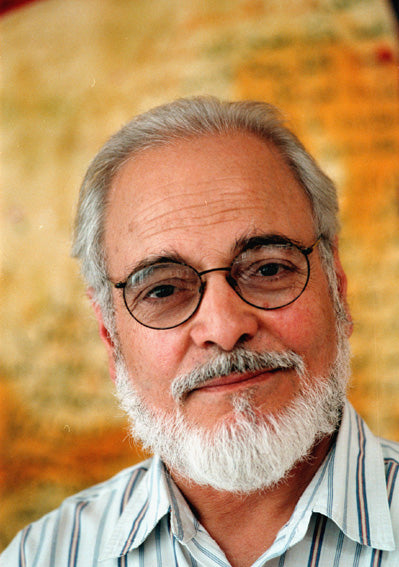
Tributes paid to leading Arab artist, Ali Omar Ermes
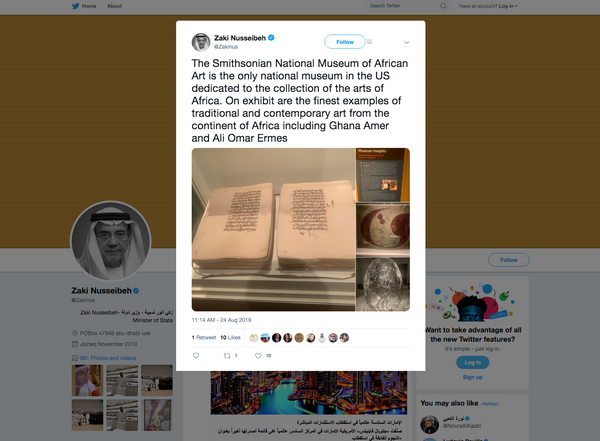
The Smithsonian National Museum of African Art exhibiting a Ali Omar Ermes artwork
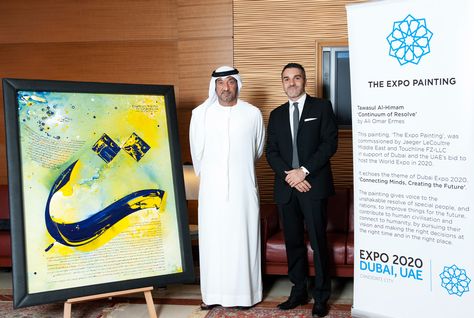
Jaeger-lecoultre Proudly Celebrates the Spirit of Invention of Dubai Expo 2020 by Presenting a Specially Commissioned Painting to the Higher Committee
Jaeger-LeCoultre Middle East Brand Director Renaud Pretet and members of the Touchline board were recently received by His Highness Sheikh Ahmed bin Saeed Al Maktoum, Chairman of the Higher Committee for Dubai Expo 2020 to present the special painting ‘Tawasul Al-Himam’ (The Continuum of Resolve) by Ali Omar Ermes. The great work of art was commissioned by Jeager-LeCoultre and Touchline FZ-LLC in celebration of Dubai’s expo theme.
